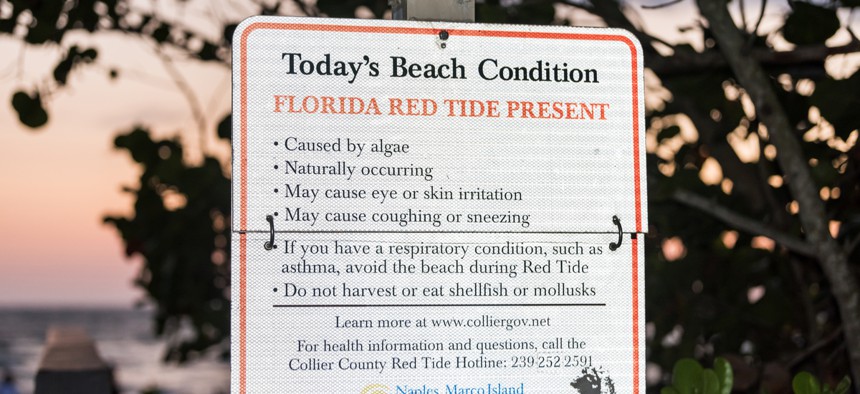Hurricane Michael Could Turn Florida’s 'Red Tide.' But How?

Shutterstock

Connecting state and local government leaders
If the storm lowers water temperatures, it might temper the growth of algae blooms.
There’s usually not even a sliver of good news that accompanies the approach of a hurricane. Yet for the west coast of Florida, struggling with red tide—the toxic algae bloom that’s killed tons of fish and hammered the region’s tourism industry over the past few months—Hurricane Michael’s expected arrival presents the possibility of some positive change.
The coming storm could have potentially fatal consequences if it makes landfall tomorrow on the US gulf coast (Oct. 10) as forecast after moving north from Cuba. Experts say they can’t be sure Michael will help dissipate the red tide but it remains a possibility. If the storm does improve conditions, it could put an end to months of struggle for coastal communities along a 145-mile stretch of Florida shoreline.
Tracy Fanara, a staff scientist at Mote Marine Laboratory in Sarasota—part of an area where the toxic tide has caused respiratory problems for residents and killed countless marine creatures—tells the Tampa Bay Times that past hurricanes have sometimes dispelled the deadly algae blooms that plague the gulf coast.
Of course, hurricanes can also exacerbate the situation: “In the past, it’s gone either way,” Fanara says.
If the storm lowers water temperatures, it might temper the growth of algae blooms. Red tides, which occur naturally, have become more frequent and severe due to rising temperatures in the Gulf of Mexico in recent decades, an effect thought to be caused by warming global temperatures. Serge Thomas, associate professor for environmental studies at Florida Gulf Coast University, tells the Naples Daily News that with the possibility of cooler water from hurricane winds, the bloom—composed of millions of minuscule, single-celled plant-like organisms—could stop spreading.
Similarly, lots of churn in the water caused by the hurricane may also move the toxic blooms northward, providing some relief for some ailing coastal communities while impacting others negatively. On Aug. 13, Florida governor Rick Scott declared a state of emergency in Hillsborough, Collier, Lee, Charlotte, Sarasota, Manatee and Pinellas counties.
Still, if the hurricane and its storm surges lead to extensive flooding, it’s likely that—whether or not there is immediate relief—the red tide eventually will worsen. ”If retention/detention ponds overflow, if septic tanks and sewage systems are overflowing…that could fertilize the algae,” says Thomas.
One human contributor to increased toxic algae blooms is industrial runoff. In September 2017, Hurricane Irma struck Florida and the US Army Corps of Engineers dumped loads of nutrient-ridden water from Lake Okeechobee into gulf waters to manage the Hoover Dike. The latest red tide began about a month later and has been linked to Irma responses. It’s continued unabated ever since.
A similar scenario now will only make the water more toxic for marine life and hurt local tourism. So, Florida’s struggling west coast is bracing for the possibility that more trouble is on its way—all while hoping Michael somehow turns out to be a cloud with a silver lining.
Ephrat Livni writes for Quartz, where this article was originally published.

NEXT STORY: Two GOP Governors, 15 AGs Urge Supreme Court to Hear Gun Case




